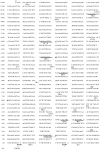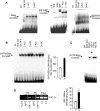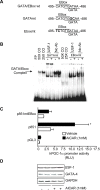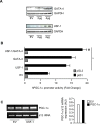AMP-activated protein kinase-regulated activation of the PGC-1alpha promoter in skeletal muscle cells
- PMID: 18974883
- PMCID: PMC2570798
- DOI: 10.1371/journal.pone.0003614
AMP-activated protein kinase-regulated activation of the PGC-1alpha promoter in skeletal muscle cells
Abstract
The mechanisms by which PGC-1alpha gene expression is controlled in skeletal muscle remains largely undefined. Thus, we sought to investigate the transcriptional regulation of PGC-1alpha using AICAR, an activator of AMPK, that is known to increase PGC-1alpha expression. A 2.2 kb fragment of the human PGC-1alpha promoter was cloned and sequence analysis revealed that this TATA-less sequence houses putative consensus sites including a GC-box, a CRE, several IRSs, a SRE, binding sites for GATA, MEF2, p 53, NF-kappaB, and EBox binding proteins. AMPK activation for 24 hours increased PGC-1alpha promoter activity with concomitant increases in mRNA expression. The effect of AICAR on transcriptional activation was mediated by an overlapping GATA/EBox binding site at -495 within the PGC-1alpha promoter based on gel shift analyses that revealed increases in GATA/EBox DNA binding. Mutation of the EBox within the GATA/EBox binding site in the promoter reduced basal promoter activity and completely abolished the AICAR effect. Supershift analyses identified USF-1 as a DNA binding transcription factor potentially involved in regulating PGC-1alpha promoter activity, which was confirmed in vivo by ChIP. Overexpression of either GATA-4 or USF-1 alone increased the p851 PGC-1alpha promoter activity by 1.7- and 2.0-fold respectively, while co-expression of GATA-4 and USF-1 led to an additive increase in PGC-1alpha promoter activity. The USF-1-mediated increase in PGC-1alpha promoter activation led to similar increases at the mRNA level. Our data identify a novel AMPK-mediated regulatory pathway that regulates PGC-1alpha gene expression. This could represent a potential therapeutic target to control PGC-1alpha expression in skeletal muscle.
Conflict of interest statement
Figures

 p 2215,
p 2215,  p 1164,
p 1164,  p 851,
p 851,  p501,
p501,  p 191 as shown in Fig. 2.
p 191 as shown in Fig. 2.



Similar articles
-
Interactions between ROS and AMP kinase activity in the regulation of PGC-1alpha transcription in skeletal muscle cells.Am J Physiol Cell Physiol. 2009 Jan;296(1):C116-23. doi: 10.1152/ajpcell.00267.2007. Epub 2008 Nov 12. Am J Physiol Cell Physiol. 2009. PMID: 19005163
-
Effect of exercise intensity and AICAR on isoform-specific expressions of murine skeletal muscle PGC-1α mRNA: a role of β₂-adrenergic receptor activation.Am J Physiol Endocrinol Metab. 2011 Feb;300(2):E341-9. doi: 10.1152/ajpendo.00400.2010. Epub 2010 Nov 23. Am J Physiol Endocrinol Metab. 2011. PMID: 21098736
-
Effects of alpha-AMPK knockout on exercise-induced gene activation in mouse skeletal muscle.FASEB J. 2005 Jul;19(9):1146-8. doi: 10.1096/fj.04-3144fje. Epub 2005 May 5. FASEB J. 2005. PMID: 15878932
-
Deacetylation of PGC-1α by SIRT1: importance for skeletal muscle function and exercise-induced mitochondrial biogenesis.Appl Physiol Nutr Metab. 2011 Oct;36(5):589-97. doi: 10.1139/h11-070. Epub 2011 Sep 2. Appl Physiol Nutr Metab. 2011. PMID: 21888529 Review.
-
PGC-1alpha-mediated adaptations in skeletal muscle.Pflugers Arch. 2010 Jun;460(1):153-62. doi: 10.1007/s00424-010-0834-0. Epub 2010 Apr 19. Pflugers Arch. 2010. PMID: 20401754 Review.
Cited by
-
p53 orchestrates the PGC-1α-mediated antioxidant response upon mild redox and metabolic imbalance.Antioxid Redox Signal. 2013 Feb 1;18(4):386-99. doi: 10.1089/ars.2012.4615. Epub 2012 Sep 20. Antioxid Redox Signal. 2013. PMID: 22861165 Free PMC article.
-
Adeno-associated virus-based caveolin-1 delivery via different routes for the prevention of cholesterol gallstone formation.Lipids Health Dis. 2022 Oct 27;21(1):109. doi: 10.1186/s12944-022-01718-7. Lipids Health Dis. 2022. PMID: 36303150 Free PMC article.
-
The Molecular Mechanism of GhbHLH121 in Response to Iron Deficiency in Cotton Seedlings.Plants (Basel). 2023 May 11;12(10):1955. doi: 10.3390/plants12101955. Plants (Basel). 2023. PMID: 37653872 Free PMC article.
-
Multiple signaling pathways regulate contractile activity-mediated PGC-1α gene expression and activity in skeletal muscle cells.Physiol Rep. 2014 May 19;2(5):e12008. doi: 10.14814/phy2.12008. Print 2014 May 1. Physiol Rep. 2014. PMID: 24843073 Free PMC article.
-
Peroxisome proliferator-activated receptor γ coactivator 1α and FoxO3A mediate chondroprotection by AMP-activated protein kinase.Arthritis Rheumatol. 2014 Nov;66(11):3073-82. doi: 10.1002/art.38791. Arthritis Rheumatol. 2014. PMID: 25047750 Free PMC article.
References
-
- Holloszy JO. Biochemical adaptations in muscle. Effects of exercise on mitochondrial oxygen uptake and respiratory enzyme activity in skeletal muscle. J Biol Chem. 1967;242:2278–2282. - PubMed
-
- Holloszy JO, Coyle EF. Adaptations of skeletal muscle to endurance exercise and their metabolic consequences. J Appl Physiol. 1984;56:831–838. - PubMed
-
- Hawley JA. Exercise as a therapeutic intervention for the prevention and treatment of insulin resistance. Diabetes Metab Res Rev. 2004;20:383–393. - PubMed
-
- Irrcher I, Adhihetty PJ, Joseph AM, Ljubicic V, Hood DA. Regulation of mitochondrial biogenesis in muscle by endurance exercise. Sports Med. 2003;33:783–793. - PubMed
-
- Hood DA. Invited Review: contractile activity-induced mitochondrial biogenesis in skeletal muscle. J Appl Physiol. 2001;90:1137–1157. - PubMed
Publication types
MeSH terms
Substances
LinkOut - more resources
Full Text Sources
Miscellaneous

